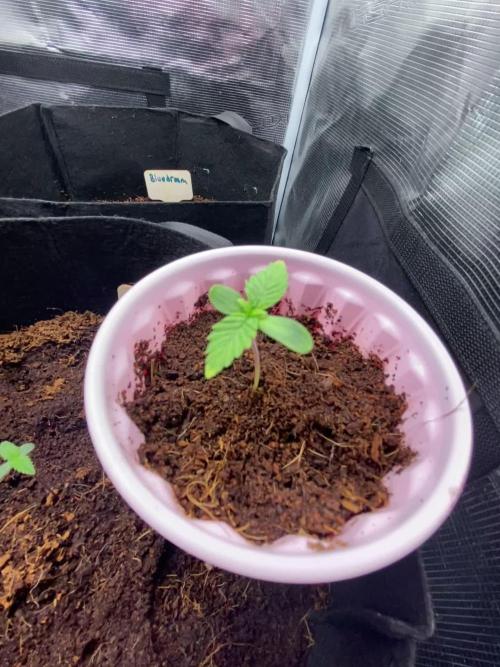By continuing to use the website or clicking Accept you consent to our cookies and personal data policy and confirm that you are at least 18 year old. For details please see Privacy Policy and Terms
Accept
Likes
20
Share


@Mosquito_Haarlem
Follow
Ze heeft het naar haar zin en wordt steeds dikker.
Heb wat spintmijt gezien, maar was er op tijd bij en heb haar een knoflookwater behandeling gegeven. Er zijn geen beestjes meer te bekennen.
Bladeren die al wat aangetast waren en de grote bladeren die veel licht blokkeerden heb ik weggeknipt.
Verder doet ze het zeer goed.
Dag 60: Het lijkt er op dat ze de honing die is meegegeven met haar voeding erg lekker vindt.
De toppen zijn in massa toegenomen de laatste paar dagen.
Dag 62: Vanaf morgen ga ik haar alleen nog water (Spa Reine) geven dus flushen.
De voeding van Plagron heeft haar laten smullen.🌳 Zeer tevreden.
Wordt vervolgd...
Likes
6
Share


@Krautbauern
Follow
She was extremly fast and ready to harvest after 55 days of flowering.
Smells a bit like ripe grapes.
Likes
12
Share


@Jays_Not_Here_Man
Follow
The girls bounced back very nicely from their topping! They are growing out, rather than up and are on their way to filling out my tent.
I will be transplanting these ladies next week, probably to a 4 gallon tall pot. I am thinking I want to flower sooner rather than waiting the typical 8 weeks of Veg that I usually do…
Processing
Likes
4
Share


@DoItBigGrows
Follow
Made some major upgrades to the environment. Moved the girls into a Vivosun 4x4 Tent and certainly not looking back. Loving it so much. Also grabbed a Spiderfarmer LED SF1000 or the rest of veg and by the time flower hits we shall have 2 Spiderfarmers ;) also did an extra topping on both! Not gonna undermine this grow one bit.
Likes
27
Share


@Stigghiola
Follow
Questa settimana ho deciso di cambiare lampada tornando ad usare una vecchia hps che usavo prima, e ho notato che i risultati sono ottimi, con la lampada a LED sembrava che la fioritura stesse durando un'eternità, perciò ho provato a cambiare per vedere se la fioritura potesse velocizzarsi e sembra essere così.
AGGIORNAMENTO:
Giorno 8 NOVEMBRE, ho dato una bella sfoltita a tutte le bimbe, credo che questa sia l'ultima volta che le tocco anche perché questa volta ho eliminato alcuni rami veramente inutili e superflui.
Likes
117
Share


@PEAKYPLANTERS
Follow
Hi everyone, Weed brothers!
This genetics is really a rock!
Strong and resistant stems and a beautiful roof of flowers
No signs of deficiencies .... I think I'm going very well .... hopefully in an excellent harvest
SEE YOU AROUND
Likes
53
Share


@GanjaGecko
Follow
In Woche 8 bei den BlueberryMuffins war viel los. Die Sanlight musste täglich neu auf die 40cm Abstand gehängt werden. Hier und da wurden immer mal wieder ein paar Blätter entfernt die Triebspitzen verdecken oder so dicht gewachsen waren das es zu einer schlechten Luftzirkulation gekommen wäre.
Die zweite Lage vom Scrog-Netz wurde installiert. So können die gestreckten Triebe wieder etwas ordentlicher untergebracht werden und werden dazu etwas gestützt wenn es in die Blüte geht. An den Stangen vom unteren Scrog-Netz wurden noch zwei PC-Lüfter angebracht um unter dem Blätterdach für etwas Luftzirkulation zu sorgen.
Den optimalen VPD zu halten war etwas schwierig bei dem Wetter zur Zeit. Die Temperaturen lagen um die 24°C und die Luftfeuchtigkeit um die 60%. Mit kurzweiligem Lüften des Raumes ging es immer mal wieder in die Richtung der angestrebten 50%. Da werden es die hoffentlich bald kälteren Tage wieder etwas angenehmer machen den VPD in den optimalen Bereich zu bekommen.
_____________________________
Düngen :
Gegossen wird mit Wasser das min. 24h mit einer Aquariumpumpe in einer 10L Gießkanne in Bewegung gehalten wird. Davon wird soviel genommen wie es die Ladys verlangen und mit dem einen oder anderen Zusatz versetzt. Je nach Stadium der der Ladys. Ab ungefähr Woche 5 wird mit 10% vom Topfvolumen gegossen. Das ganze wird in drei Teilen mit einem Abstand von 20-30min gegossen.
Tag50 gab es für die BlueberryMuffins 1ml/L PowerRoots, 1ml/L PureZym und 1ml/L PowerBuds. Das ganze wurde auf einen ph-Wert von 6.5 gebracht. Es gab je Lady 1L in den Topf und 200ml in den Untersetzer.
An Tag52 gab es 1ml/L PowerRoots, 1ml/L PowerBuds, 1ml/L PureZym, 1.5ml/L PK 5•8 und 2ml/L StickyFingers. Das ganze wurde auf einen ph-Wert von 6.5 gebracht. Jede Lady bekam 200ml in den Untersetzer und 1L in den Topf.
Tag55 gab es 1ml/L PowerRoots, 1ml/L, 1ml/L PowerBuds, 2ml/L PK 5•8, 2ml/L StickyFingers und 1g/L BioEnhancer. Das ganze wurde auf einen ph-Wert von 6.5 gebracht Jede Lady bekam 1L in den Topf und 200ml in den Untersetzer.
________________________________
Höhe gemessen ab Substratoberfläche
#1 62cm
#2 66cm
#3 37cm
______________________________
Licht
Abstand: 40cm
Watt: 100W (50%)
Ppfd: 550
DLI: 24
Likes
18
Share


@Chubbs
Follow
420Fastbuds
GelatoAuto
Week 4
What up grow fam. Weekly update on these 3 wonderful ladies. This week I did introduce some nutes and the plants seem to respond amazing. Starting to see little pistols so guessing this will be the last week of veg before the transition into flower. All in all Happy Growing
Likes
13
Share


@XanHalen
Follow
Mar 24:
Watering till runoff now...
runoff ppm was 2500+...
Will be using very mild nutes to flush over 1 - 3 feeds... or until I am near my input.
Mar 26:
Continuing to use 650ppm feed with bloom focus, 2L per plant gives 15% runoff...
Runoff ppm is still very high...
I wanted to check pH of runoff but the color is so vibrant i cant use the pH drops to view color, need to get a pH probe.
Plants are thriving, no issues at all. the extra fan fixed the post-water droop.
One plant is bushy and has the most bud sites,
One is the smallest but has the most uniform structure, this one has the biggest buds and thickest stalk,
One is about in the middle of the 2.
Mar 29:
one of these girls gets droopy early when its time for water, thought the canopy was too high so i tied down some more, no cigar...
gonna try increasing calmag, if that doesent work im going to reposition in the grow box to a side instead of middle, may not need the upper end ppfd...
Likes
3
Share


@Xabii
Follow
DISCLAIMER START
EC Value on weekly page is the actual value, my EC meter was not calibrated and gave extremely false values, that's why it went so bad, corrected it on the weekly page when I noticed it, the EC value in the comment is wrong, the rest is correct.
DISCLAIMER END
The plant keeps growing super slow and doesn't like "high" EC, after the Increase in EC last week it got stunted and a couple days later started to show tip burn.
Really really frustrated and if this one was in my usual setup I would have tossed it out of the window.
New growth after topping is also growing EXTREMELY slow.
Did some defoliation to get light to lower nodes but ya whatever the plant doesn't care and doesn't want to grow.
Unsure if it is due to this pheno, the new setup, the new light or whatever, to many variables to definitely say.
I see this grow as a big experiment from now on and don't expect anything anymore.
Added some Universol Yellow (high P) after lowering EC due to tip burn.
Changed the light to my old one the SP3000 to see if the higher amount of far red is helping it to stretch.
Plant started to flower properly mid week so I'll start to mark it as flowering starting next week.
On one leaf there is a bud starting to form.
Values are average of the day.
DATE - EC(us/cm)
20250315 1696
20250316 1630
20250317 1433
20250318 1406
20250319 1398
20250320 1323
20250321 1350
DATE - PH
20250315 6.09
20250316 5.94
20250317 5.58
20250318 5.67
20250319 5.68
20250320 5.71
20250321 5.70
DATE - ORP (mV)
20250315 49
20250316 40
20250317 80
20250318 63
20250319 51
20250320 30
20250321 45
DATE - °C - RH% (Tent Temp/RH)
20250315 23.8 43
20250316 23.2 37
20250317 23.2 43
20250318 22.9 43
20250319 22.7 53
20250320 22.8 48
20250321 23.2 44
DATE - °C (Reservoir)
20250315 20.9
20250316 21.1
20250317 19.4
20250318 18.6
20250319 18.9
20250320 19.2
20250321 19.0
DATE - CF
20250315 16.96
20250316 16.30
20250317 14.33
20250318 14.06
20250319 13.98
20250320 13.23
20250321 13.50
Likes
4
Share


@SuperGluedGrow
Follow
This week was also uneventful, growth has been slow and I'd say its half my fault with PH issues and over feeding which I'm correcting moving forward; and two unstable genetics. I dont have much info on growth patterns for this strain but its supposed to look a beautiful dark purple so I'm gonna breed a male and female hopefully. I'm also looking forward to the fourth phenos straits, I kind of hope its different just to have fourth completely unique phenos.
Likes
8
Share


@Ladyblazed
Follow
Alright, this is the best sativa ever tried, actually my first purple coloured buds. The smell is a lot like pineapples and berries. The effect so uplifting!!💜
Likes
8
Share


@DWCpaqy
Follow
Just wanna smoke! Smells amazing, now is getting real started, buds are juice and shines like a star 😍
I think my buds is a little thigth and close to each other, I tried to use some rubber band but ended up trimming some leaf. I'm not sure about fan leaf and they you need, but if they are covering building buds I take them.
Have some more weeks before havrest, when I have 2 weeks left I'm going to use terra aquatica Final Part 🙏
Happy grow bro
Likes
75
Share


@Roberts
Follow
Ice Bomb grew well under the Unit Farm UF4000, and UF2000 that was added in flowering. She was 1 of 5 in a group grow under the lights. She got nice and frosty. Smells like strawberries 🍓 to me anyway. She is suppose to be a good medical cannabis so curious to the smoke report when I get there. Thank you Bomb Seeds, and Unit Farm. 🤜🤛🌱
Thank you grow diaries community for the likes, follows, comments, and subscriptions on my YouTube channel. 🍻🌱👍 Happy Growing 🌱
https://youtube.com/channel/UCAhN7yRzWLpcaRHhMIQ7X4g


























